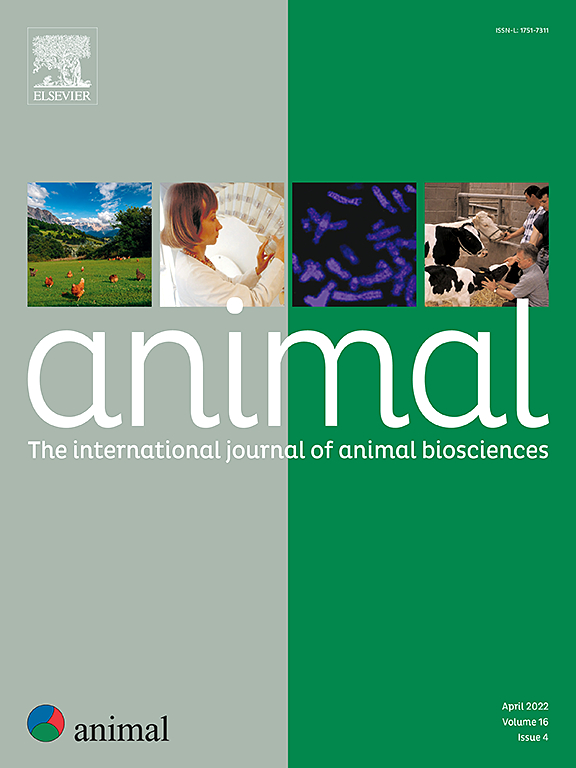Effects of early access to feed and water in hatchers on growth performance in broiler chickens
IF 4.2
2区 农林科学
Q1 AGRICULTURE, DAIRY & ANIMAL SCIENCE
引用次数: 0
Abstract
Conventional hatchers do not provide feed or water to chicks during hatch, which may negatively affect chick development, especially in early hatchlings subjected to prolonged feed deprivation due to biological variation in hatch time. This study aimed to evaluate the effects of early access to feed, water and a synbiotic product on performance, caecal microbiota development, organ development, intestinal morphology, total serum immunoglobulin (Ig) Y and antibody response to vaccination in Ross-308 chickens. A total of 330 chicks hatched in a specialised hatcher were divided into three hatch treatment groups: access to feed, water and synbiotic additive (PS); access to feed and water (PosC); no access to feed and water (NegC). Ten birds per hatch treatment were euthanised for organ sampling at placement, and the remaining 300 chicks were randomly allocated to 30 pens. All chicks received feed and water, and half the chicks in each treatment group received the synbiotic additive for 3 consecutive days (giving three hatching treatments and two postplacement treatments). All chicks were vaccinated against avian pneumovirus (APV) at 10 days of age. Blood sampling was performed weekly on three focal birds per pen for analysis of total serum IgY and antibodies to APV. Organ sampling was performed on days 11 and 32. Feed intake (FI) and BW were recorded weekly. The NegC group exhibited reduced early growth and lower FI throughout the study. At 25 days, they also demonstrated an inferior feed conversion ratio (FCR) compared with the other groups. At 4 and 25 days chickens that did not receive any postplacement treatment, None had superior FCR compared to those receiving PS also postplacement. There was also an effect of postplacement treatment where the None group weighed more compared to the PS group on almost all occasions. The NegC group had higher concentrations of IgY in serum compared to the PosC group at 3 days of age, an effect that remained a tendency until 25 days of age. No differences between treatments were found for antibody responses to APV vaccination. Some differences in relative weights of digestive organs between hatching groups were detected at the end of study, while no persistent effects on caecal microbiota composition were observed. In conclusion, delayed access to feed and water had adverse effects on productivity traits, lasting throughout the study. These findings warrant further validation in a practical context with higher stocking densities and pathogen loads.
孵化期早期饲喂饲料和水分对肉鸡生长性能的影响
传统的孵化器在孵化过程中不提供饲料或水,这可能会对雏鸟的发育产生负面影响,特别是在早期孵化的雏鸟由于孵化时间的生物变异而长期缺乏饲料。本试验旨在评价早期饲喂饲料、水和一种合成产物对Ross-308鸡生产性能、盲肠菌群发育、器官发育、肠道形态、血清总免疫球蛋白(Ig) Y和免疫应答的影响。在一个专门的孵化器中孵化的330只小鸡被分为三个孵化处理组:获得饲料,水和合成添加剂(PS);获得饲料和水;无法获得食物和水(NegC)。每个孵化处理对10只雏鸡实施安乐死,在放置时进行器官取样,其余300只雏鸡随机分配到30个围栏中。所有雏鸡均饲喂饲料和水,每个处理组各有一半雏鸡连续3天(给予3个孵化处理和2个放置后处理)。所有雏鸡均在10日龄接种禽流感肺炎病毒(APV)疫苗。每周对每栏3只焦点鸟进行血样采集,分析血清IgY和APV抗体。在第11天和第32天进行器官取样。每周记录采食量(FI)和体重。在整个研究过程中,NegC组表现出早期生长减少和较低的FI。25日龄时,它们的饲料系数也低于其他各组。在第4天和第25天,未接受任何放置后处理的鸡的FCR均优于同样放置后接受PS处理的鸡。安置后治疗也有影响,无组在几乎所有情况下都比PS组重。与PosC组相比,NegC组在3日龄时血清中IgY浓度较高,这种影响一直持续到25日龄。不同治疗组对APV疫苗的抗体反应无差异。研究结束时,各孵化组消化器官的相对重量存在一定差异,但对盲肠菌群组成没有持续影响。综上所述,延迟获得饲料和水对生产力性状有不利影响,并在整个研究过程中持续存在。这些发现有必要在更高的放养密度和病原体负荷的实际情况下进一步验证。
本文章由计算机程序翻译,如有差异,请以英文原文为准。
求助全文
约1分钟内获得全文
求助全文
来源期刊

Animal
农林科学-奶制品与动物科学
CiteScore
7.50
自引率
2.80%
发文量
246
审稿时长
3 months
期刊介绍:
Editorial board
animal attracts the best research in animal biology and animal systems from across the spectrum of the agricultural, biomedical, and environmental sciences. It is the central element in an exciting collaboration between the British Society of Animal Science (BSAS), Institut National de la Recherche Agronomique (INRA) and the European Federation of Animal Science (EAAP) and represents a merging of three scientific journals: Animal Science; Animal Research; Reproduction, Nutrition, Development. animal publishes original cutting-edge research, ''hot'' topics and horizon-scanning reviews on animal-related aspects of the life sciences at the molecular, cellular, organ, whole animal and production system levels. The main subject areas include: breeding and genetics; nutrition; physiology and functional biology of systems; behaviour, health and welfare; farming systems, environmental impact and climate change; product quality, human health and well-being. Animal models and papers dealing with the integration of research between these topics and their impact on the environment and people are particularly welcome.
 求助内容:
求助内容: 应助结果提醒方式:
应助结果提醒方式:


